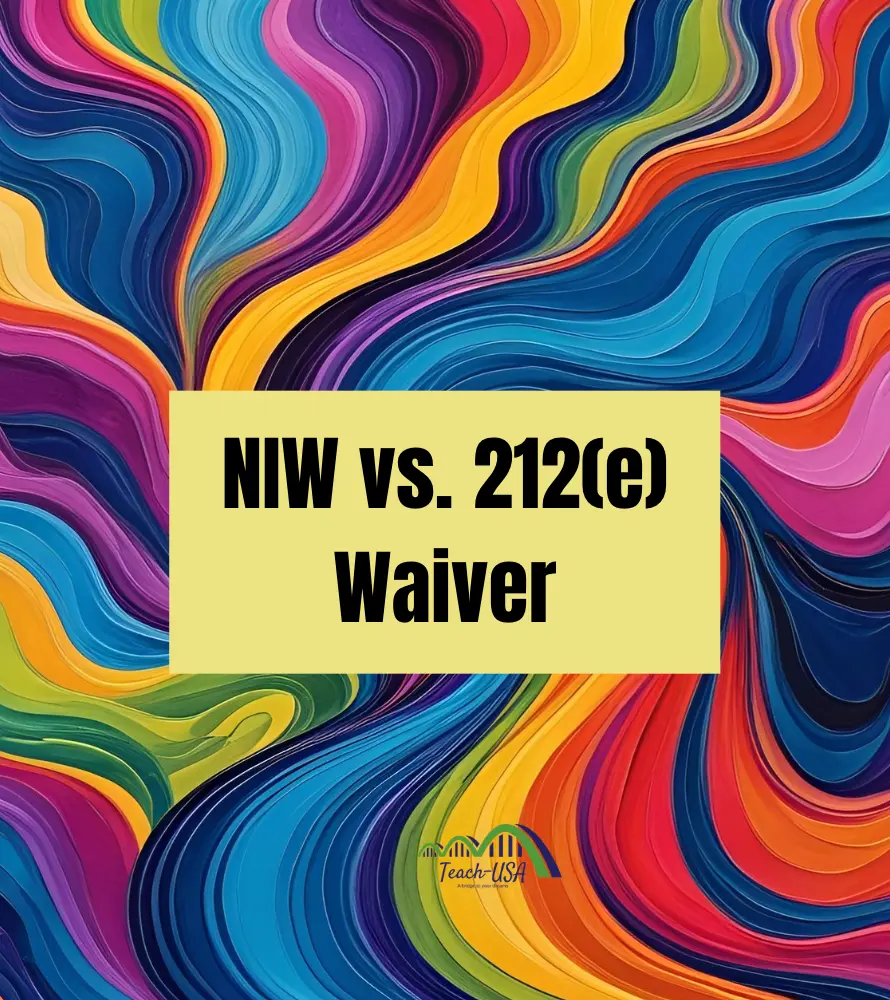If you’re a J-1 teacher in the U.S., chances are you’ve heard about the 212(e) waiver and the National Interest Waiver (NIW). These two terms come up often, and many teachers mistakenly think they’re the same.
They’re not. And knowing the difference could save you time, money, and even your future in the U.S.
What Is the 212(e) Rule?
Most J-1 visa holders are subject to the two-year home residency requirement, known as 212(e).
This means that after your J-1 program ends, you must return to your home country for at least two full years before you can:
- Change your visa status inside the U.S.
- Apply for permanent residency (green card).
- Apply for another long-term visa, such as H-1B.
The only way to remove this requirement is to apply for a 212(e) waiver.
What the 212(e) Waiver Really Does
A 212(e) waiver is simply permission to bypass the two-year home residency rule.
- ✅ If approved, it allows you to adjust your status or change visas without going home first.
- ❌ But it does not automatically give you another visa or green card.
Here’s the catch: even if you have a 212(e) exemption or approval, you still need another visa or status lined up. Otherwise, you will still have to return home when your J-1 ends.
This is where having an H-1B sponsor or an NIW petition filed within the right timeframe becomes critical.
What Is the National Interest Waiver (NIW)?
The National Interest Waiver (NIW) is completely different.
It’s an employment-based green card petition that does not require employer sponsorship. Instead, you are asking the U.S. government to waive the usual job-offer requirement because your work is in the national interest of the United States.
For teachers, especially in high-need fields like Special Education, Math, and Science, this can be a powerful pathway.
With NIW, you must prove that:
- Your work has substantial merit and national importance.
- You are well-positioned to advance your work in the U.S.
- Waiving the job-offer requirement benefits the country.
NIW vs. 212(e) Waiver — Side by Side
| 212(e) Waiver | NIW (National Interest Waiver) |
|---|---|
| Removes the J-1 two-year home residency rule | Employment-based green card petition |
| Only clears the way — doesn’t grant a new visa | Leads directly to permanent residency if approved |
| Must still secure another visa (like H-1B) or petition (like NIW) | No employer sponsorship required |
| Focus: lifting a restriction | Focus: proving your work benefits the U.S. |
Why Timing Matters
For J-1 teachers, timing is everything.
- If your J-1 is ending soon, you’ll need either a 212(e) waiver + new visa (like H-1B) OR an approved NIW petition already in process.
- If you do nothing, even with a waiver, you may still have to go home once your J-1 ends.
Key Takeaway
The 212(e) waiver and the NIW are two very different processes:
- The 212(e) waiver removes a barrier.
- The NIW opens a pathway.
Many teachers need both — first the waiver, then the NIW (or H-1B).
Understanding the distinction will help you prepare early, ask the right questions, and secure the best future for yourself and your family.
Next Steps for Teachers
📌 For 212(e) Waiver Referrals
If you want me to connect you with an immigration lawyer for your 212(e) exemption, please fill out this form:
👉 212(e) Waiver Referral Form
📌 For NIW Pre-Qualification
If you’d like to explore whether you qualify for the National Interest Waiver (NIW), email us at apply@teach-usa.net with the subject line NIW. We’ll guide you through the pre-qualification process.

